200-year-old plant specimens from historic
voyage make their television debut
Story by Jessica Keating
21 March 2024

Plant specimens collected by Charles Darwin on the famous Voyage of the Beagle between 1831 and 1836, rarely seen for 200-years, are being shown by Cambridge University researchers and curators as part of a new TV series with Susan Calman exploring Darwin’s relationship with Professor John Stevens Henslow.
Channel 5’s ‘Susan Calman’s Great British Cities’ visited Cambridge University Botanic Garden and the University’s Herbarium to see the rare plant specimens held there and discover how Henslow’s understanding of plants inspired his most famous student, Charles Darwin.
Henslow was Professor of Botany at Cambridge University and founded the current Cambridge University Botanic Garden in 1846, where the herbarium specimens reside as part of the University’s Department of Plant Sciences.
Throughout his time on the Voyage of the Beagle, Darwin was regularly posting specimens back to his teacher, friend and mentor, Professor John Stevens Henslow. Insightful letters exchanged between the two during the voyage – including Henslow complaining about Darwin’s packaging – are held at the Cambridge University Library.
Chart of the Beagle’s voyage. Charles Darwin travel map – Scanned 1880 Engraving
Specimens put on display for filming include a lichen specimen collected by Darwin in Tierra del Fuego in 1833 – believed not to have been looked at since Henslow’s time. It was uncovered ahead of the show with no classification or modern determination slips and has never been the subject of scientific or historical analysis.
Other rarely seen items were fungal herbarium specimens from Brazil that remain wrapped in the original newspaper Darwin used to preserve them on the Beagle. One news sheet shown is dated Wednesday October 22nd 1828 and priced at 7d.
Two seaweed specimens, collected by Darwin on the beach of Tierra del Fuego, also remain in an incredible condition, dated 1833 with additional details recorded by their famous collector. These particular specimens correspond with letters from Darwin, held in the Cambridge University Library (CUL), where he describes meeting the indigenous people of Tierra del Fuego and observing them on the beach.
Other specimens shown for the cameras include Opuntia (prickly pear) cacti, on which Henslow has added the name he devised for this important species “Opuntia galapagea” and where Darwin collected them, simply recorded as “Galapagos”.
These were the subject of a paper by Henslow, as well as a detailed illustration also residing in the Herbarium, that he would go on to use in his teachings. The paper recorded Darwin’s observations on how the plant integrated with its surroundings and provided a vital water source for the resident iguanas. Observations of interactions between these and similar organisms proved essential in igniting the evolutionary theories Darwin published decades later.

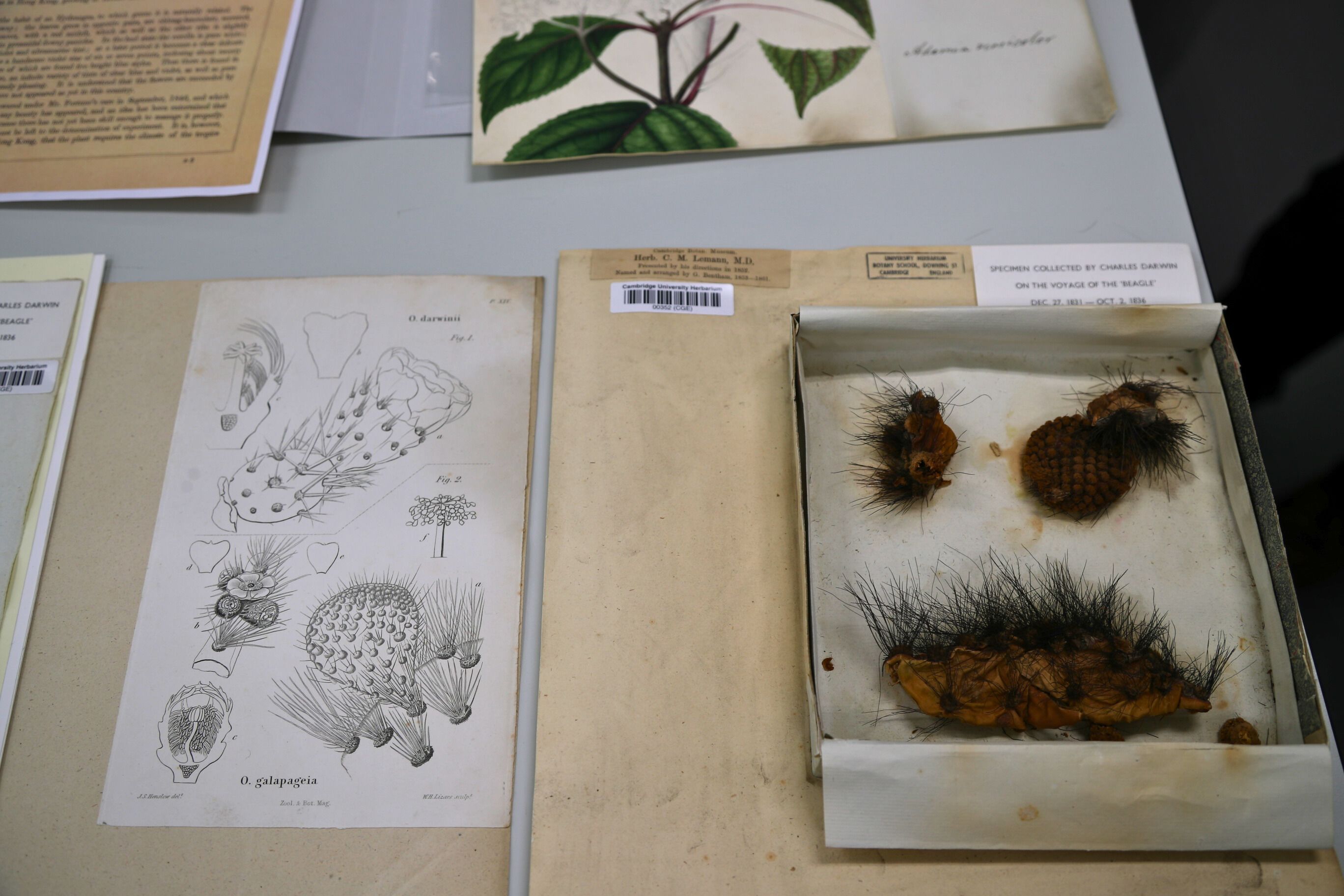
Opuntia Cacti specimens collected by Darwin in the Galapagos, next to illustrations of the plants drawn by Henslow

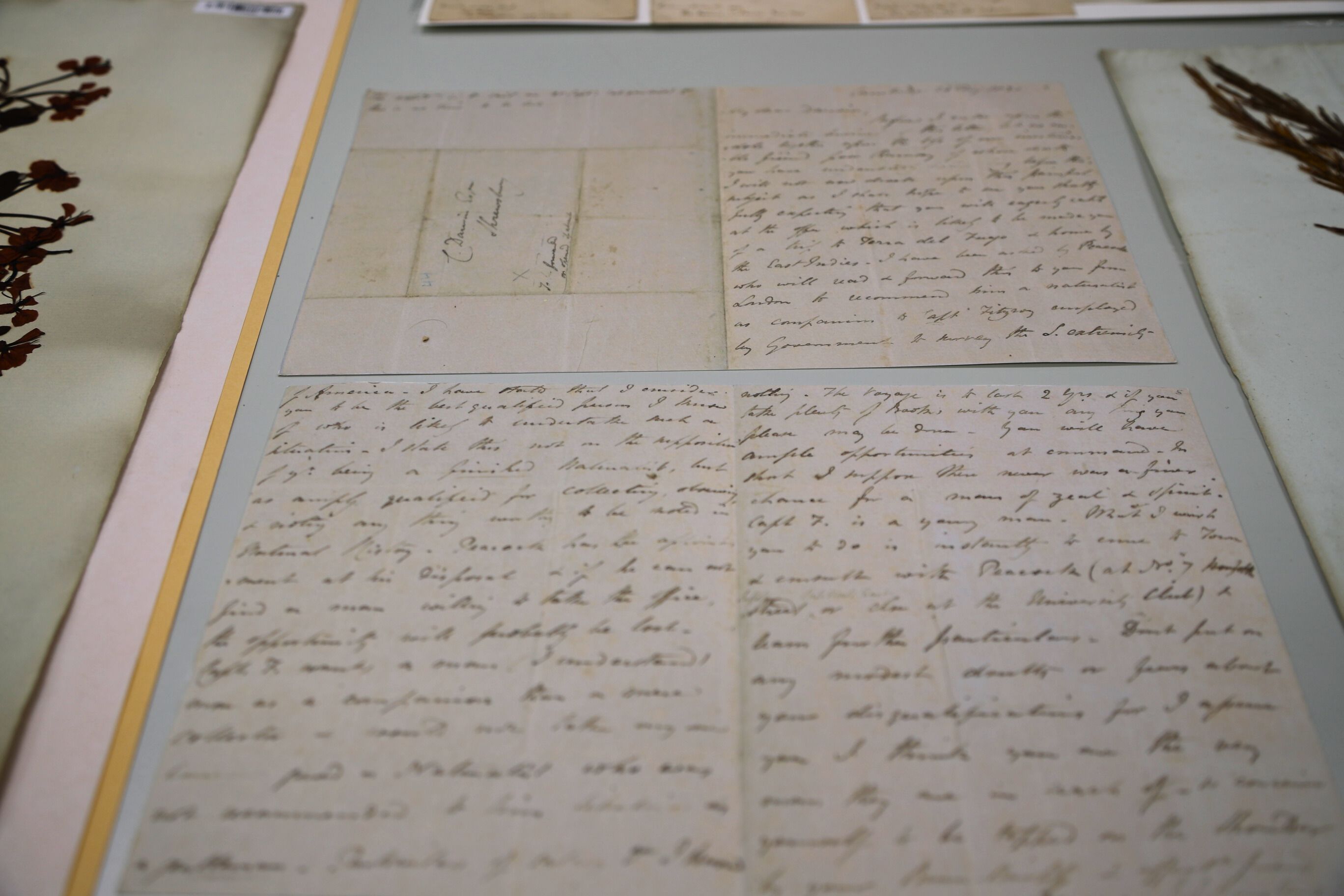
A hand-written letter from Henslow to Darwin, addressed “My dear Darwin”

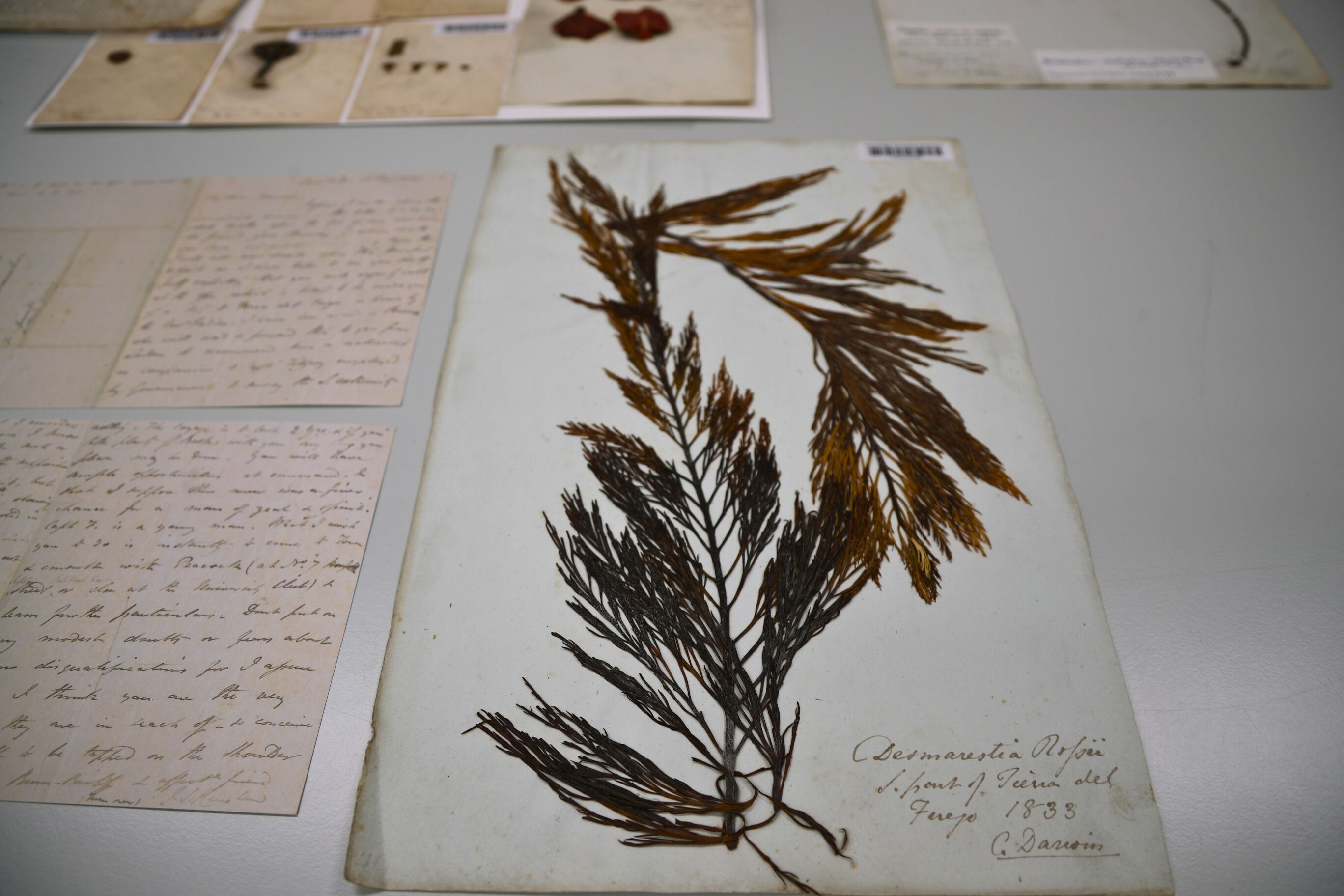
Seaweed specimens, collected by Darwin on the beach of Tierre del Fuego, signed and dated 1833

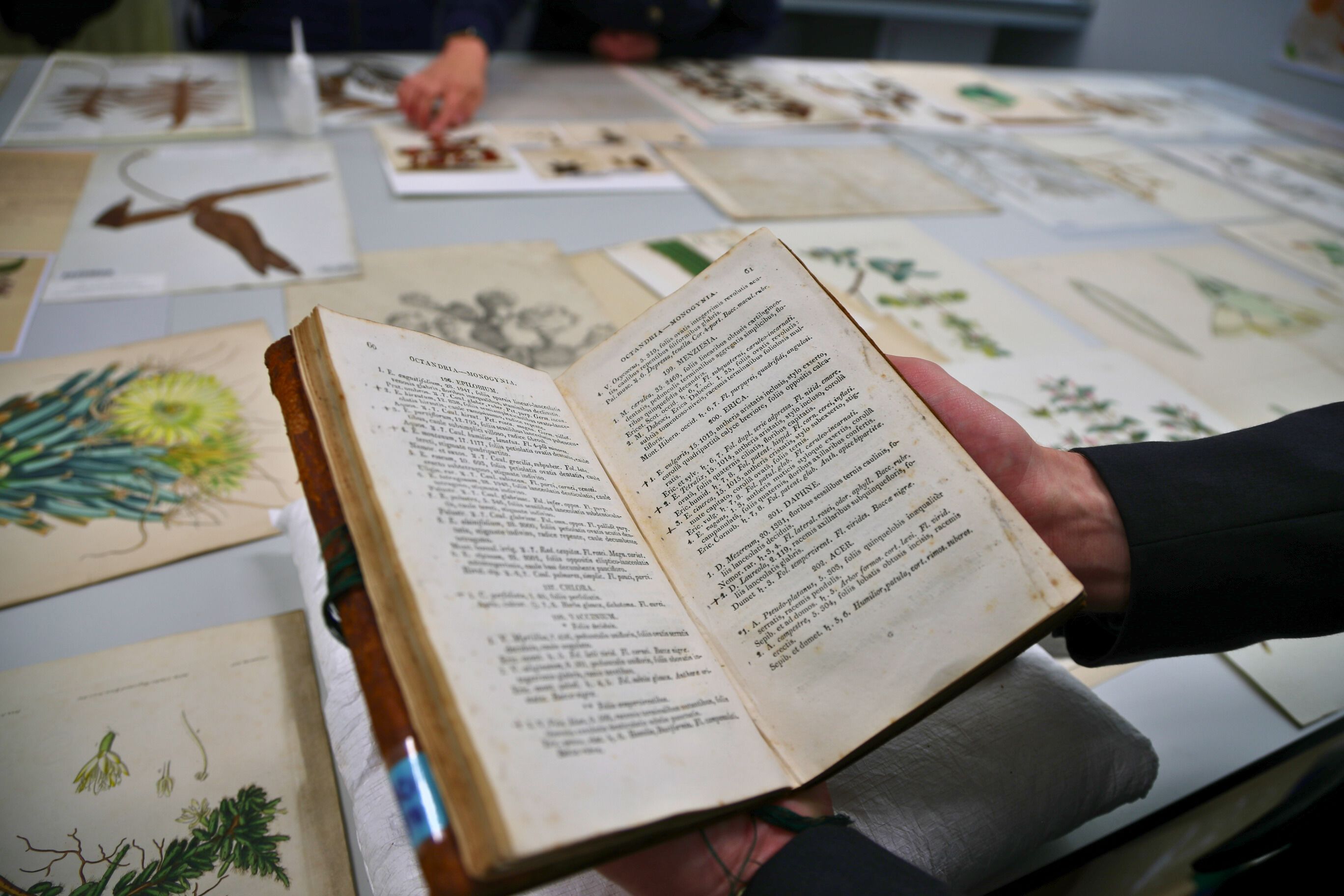
Henslow’s personal botany book

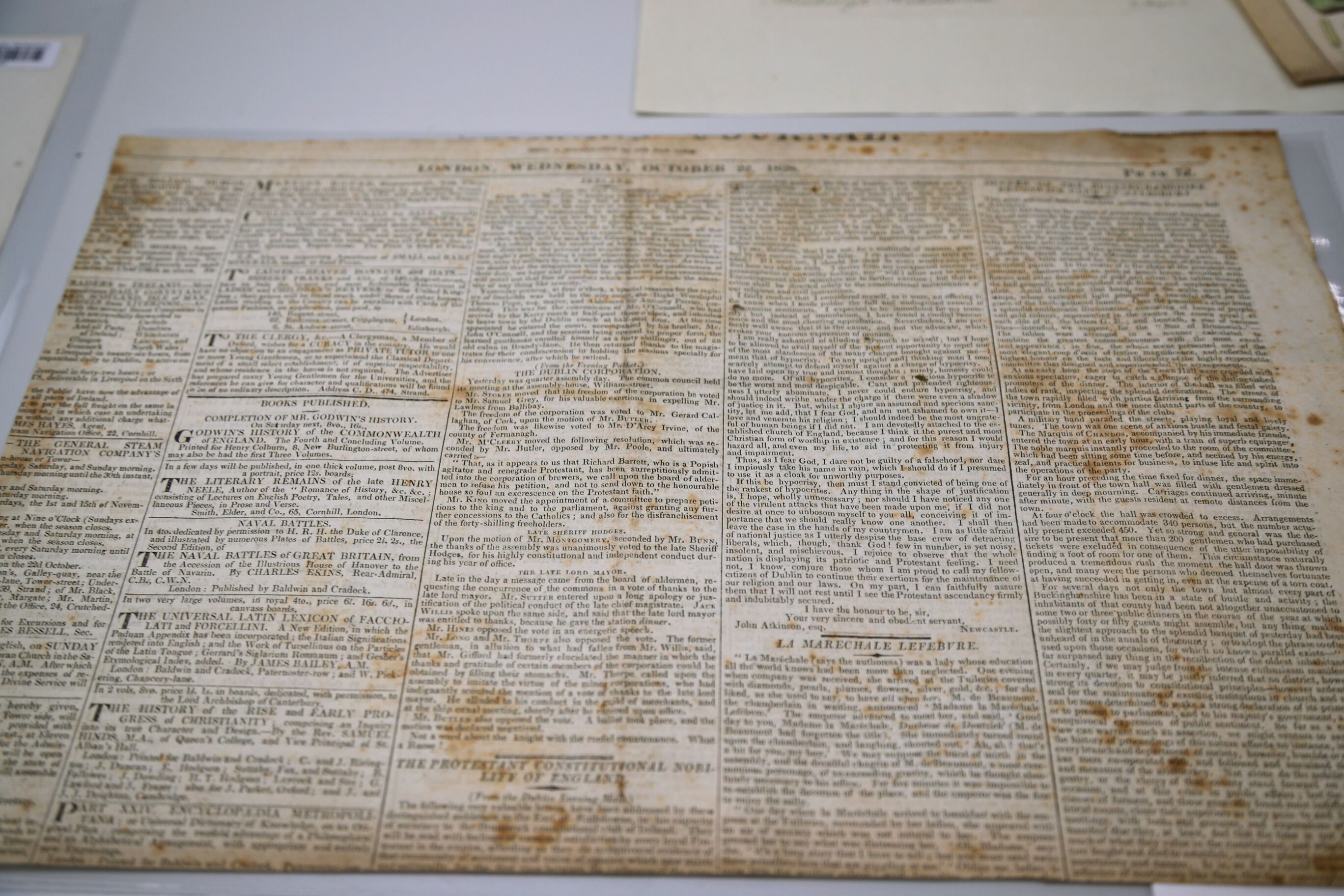
A sheet of newspaper from 1828 that Darwin took with him on the Voyage of the Beagle and used to wrap specimens in when posting them back to Henslow in Cambridge

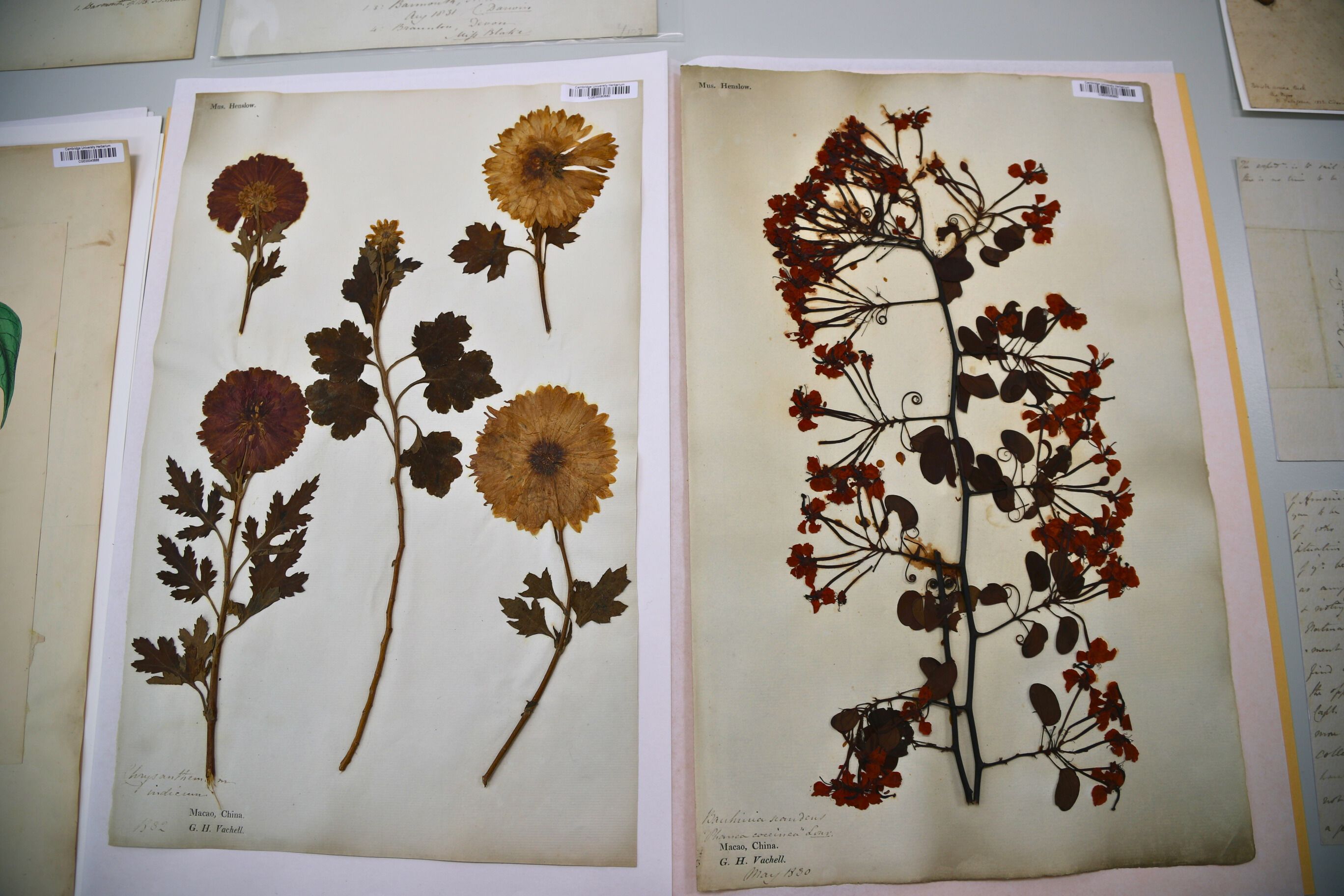

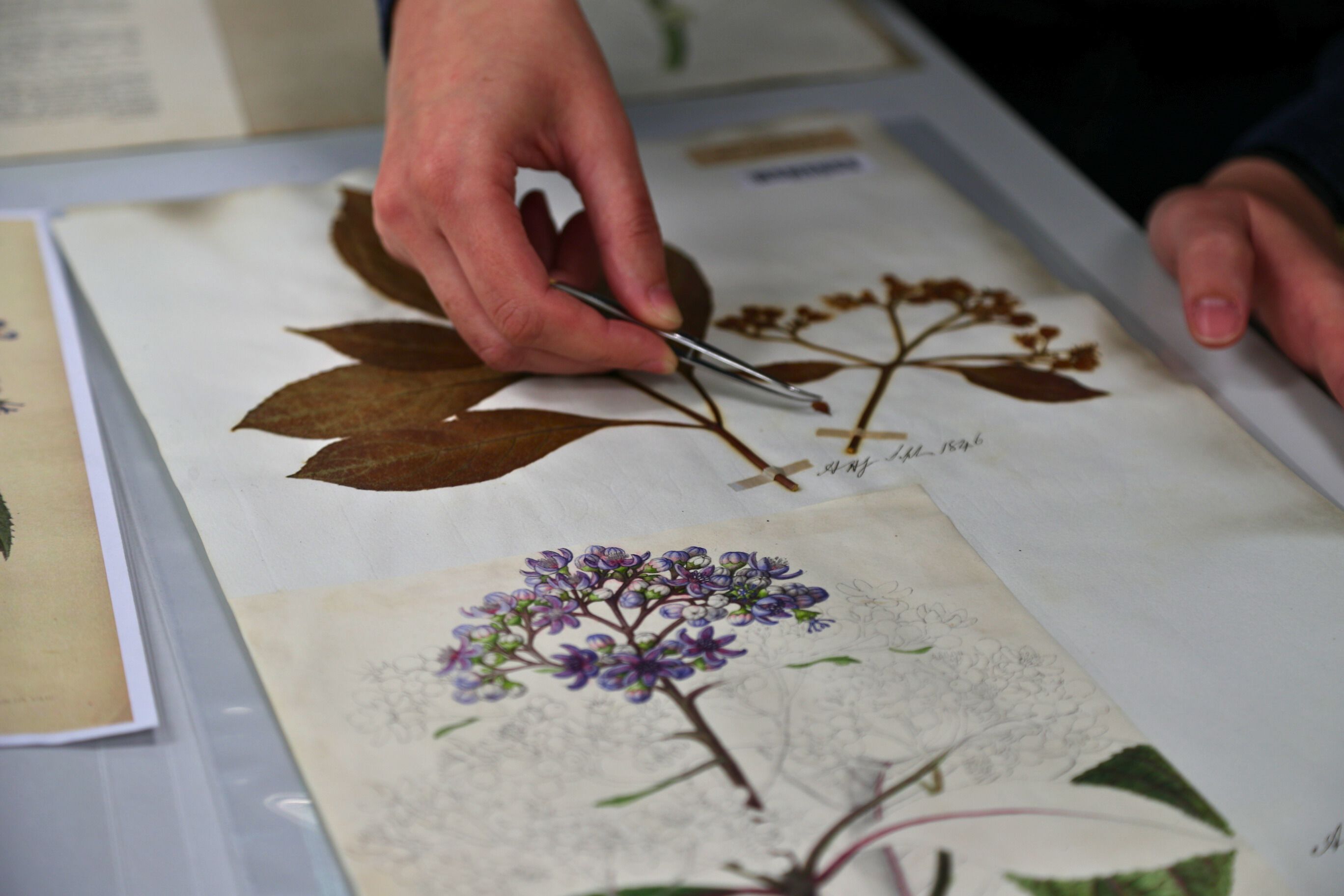
The team exploring and inspecting some of the archival collection

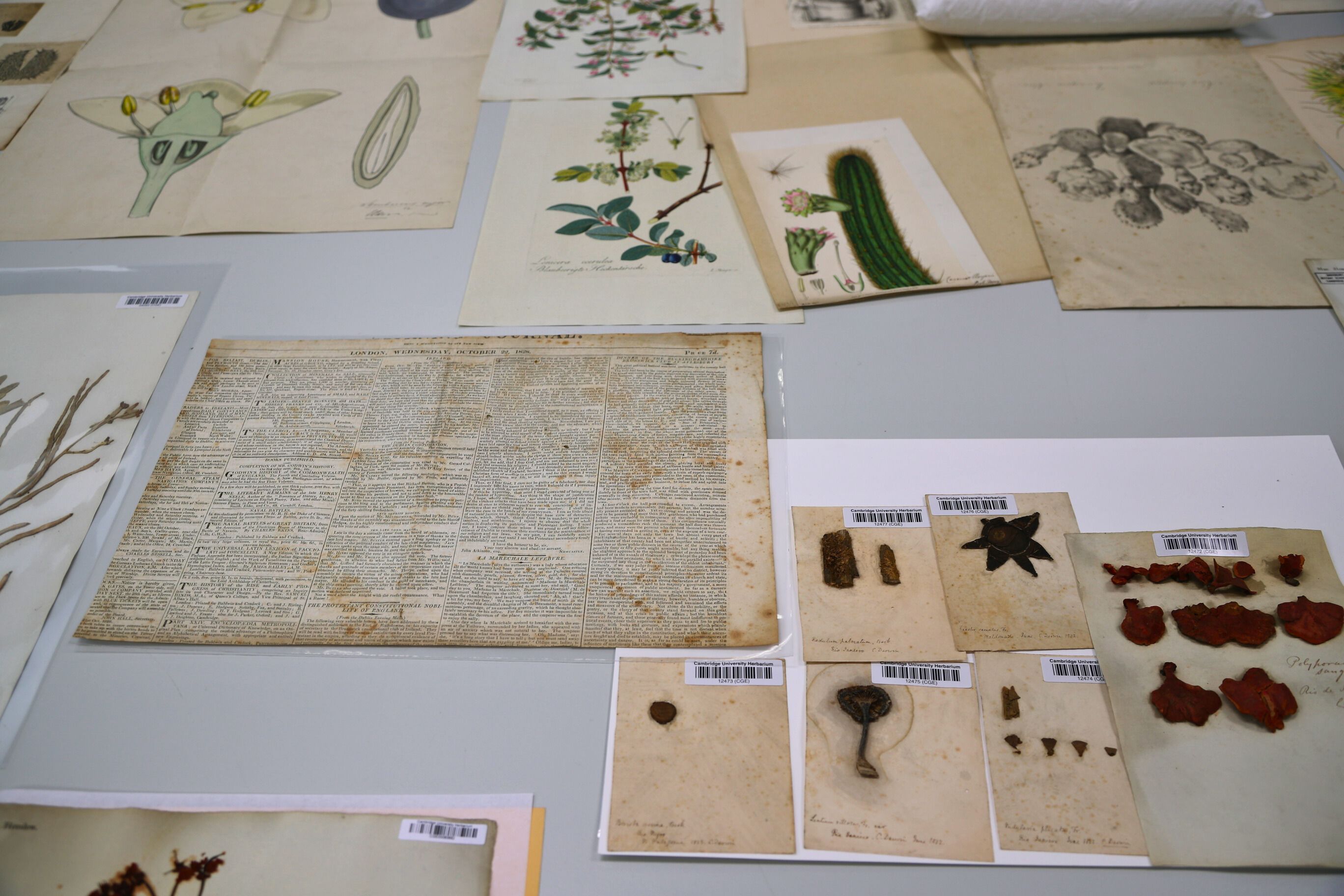
Specimens, newspaper used as wrapping and illustrations unveiled for filming
As Darwin’s Professor, Henslow was responsible for inspiring his love of natural history and it was Henslow that put him forward for the Voyage of the Beagle. Darwin later described it as “by far the most important event in my life”.
Henslow’s progressive, hands-on teaching techniques, which included meticulous observing, collecting, storing and recording were ground-breaking for the time and are why Darwin’s detailed specimens survive to this day, informing modern research.
“A major drive for the collection of plants was to explore how they interacted with the wider world in order to gain a better understanding of ‘God’s creation’. Henslow, in particular, was fascinated with plant physiology and the question of: ‘Why does God design these plants in this way?’
“Darwin was taught botany in this line known as ‘natural theology’ and there was never any doubt in God’s existence. As we know, in later life Henslow and Darwin diverged on this but that curiosity to explore plants in relation to their wider environments was sparked by Henslow’s pioneering teaching.” Dr Edwin Rose, AHRC Early Career Research Fellow and Advanced Research Fellow at Darwin College, who shows Susan Calman the specimens in the Channel 5 programme
Illustrations by Professor John Stevens Henslow that he used as teaching aids with his pupils including Charles Darwin
Other Darwin-related items held in the extensive Herbarium collection include:
- Darwin’s first ever recorded specimen, collected on a field trip with Henslow in North Wales
- The diary of Darwin’s class rival, Charles Babington, who would irritate Darwin by going to the Cambridge Fens in the early mornings to collect the ‘best’ beetles first
- Original wall charts, illustrated by Henslow (such as the one pictured above) that Darwin learned from and saw displayed in the walls of the lecture room
- Henslow’s personal copies of James Edward Smith’s Compendium floræ Britannicæ (1829), in which he notes specimens found during the numerous forays to the local countryside with students – including Darwin.
“Plant specimens like Darwin’s, and the rest of the 1.1 million we hold at the Herbarium, are vital for modern-day research. They are verifiable evidence that allows us to monitor and see how environments have changed over time, how humans have impacted specific environments and how climate has changed environments. They allow us to extrapolate information to see if the temperature was similar in the past, or if it’s changed and using modelling we can see what the environment will be like in the future. All this evidence going backwards, allows us to predict forwards and is used in a huge amount of research these days.”Dr Lauren Gardiner, Curator of the Cambridge University Herbarium
The Cambridge episode of Susan Calman’s Great British Cities will air at 9pm, 22nd March on Channel 5 and the series is also available on My5.

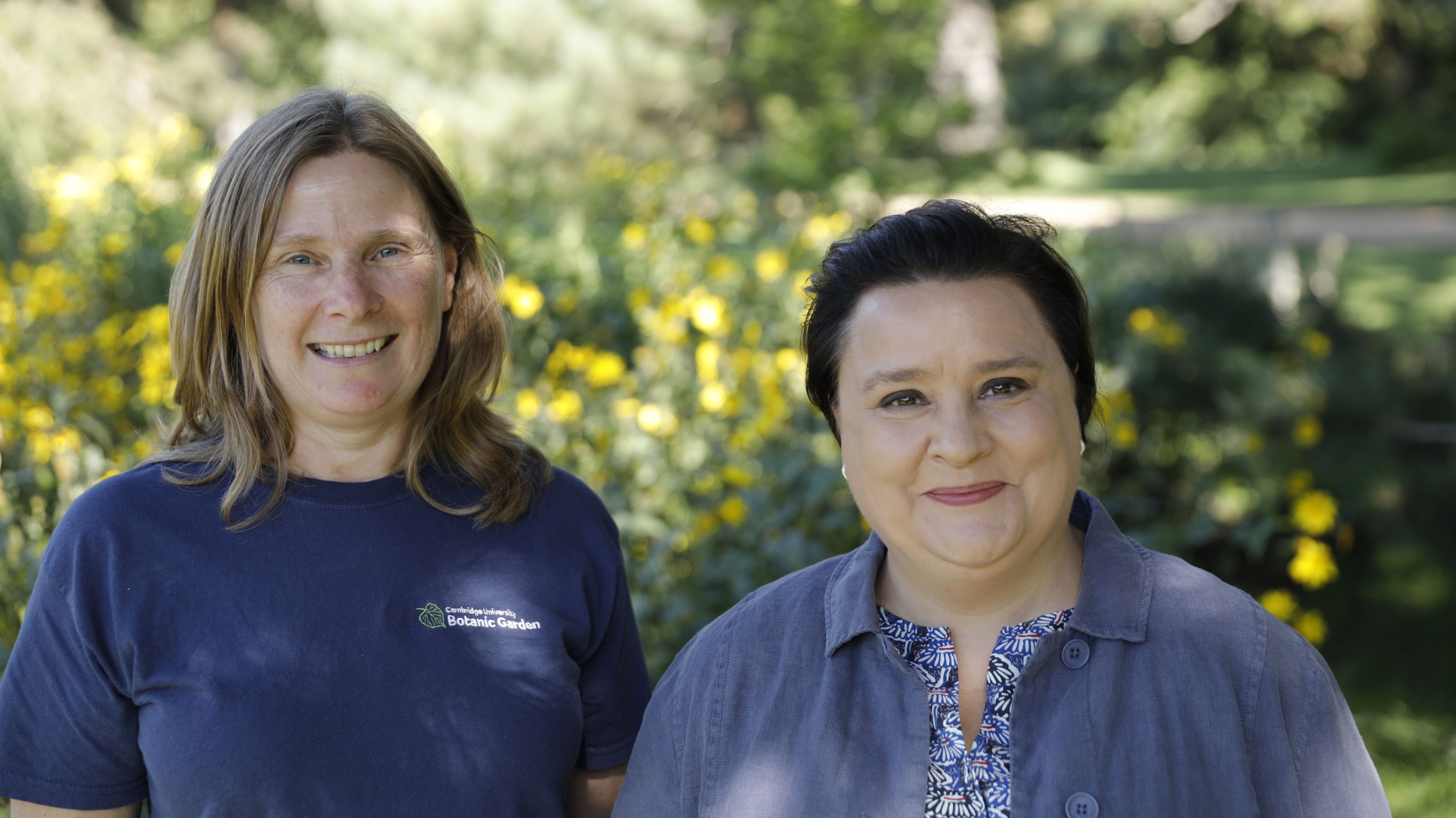
Susan Calman with Sally Petitt, CUBG Head of Horticulture. Credit: Channel 5

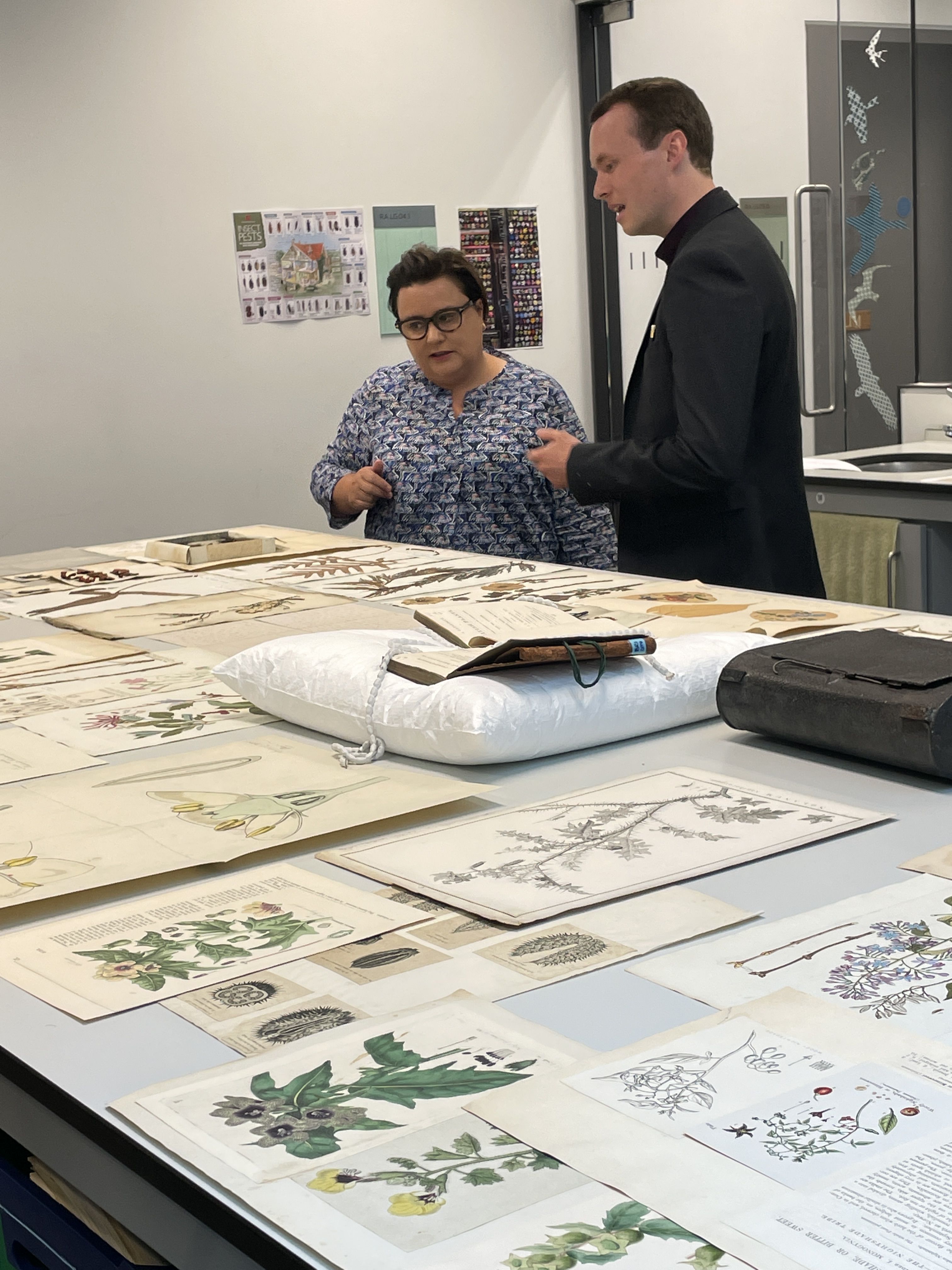
Dr Edwin Rose shows Susan Calman the archive materials during filming
Delving into Henslow and Darwin
The little-known relationship between Charles Darwin and his innovative teacher, of whom he wrote “a better man never walked this earth”
Vintage illustration of Professor John Stevens Henslow
Professor John Stevens Henslow (1796-1861) was a British botanist, clergyman, and geologist who popularised botany at the University of Cambridge by introducing new methods of teaching the subject. Notably he initiated the move of the Cambridge University Botanic Garden to its present site in 1846.
In 1822 Henslow was made Professor of Mineralogy at Cambridge and in 1825 he became Professor of Botany, where he introduced a teaching technique fostering independent discovery. His students were inspired to collect plants and asked to examine and record the characteristics of the structures they found.
This method, combined with unusual field trips, interesting lectures, and Henslow’s natural enthusiasm, made botany one of the most popular subjects at the university. His class list would extend to as many as 80 students, at a time when the total University population was only in the low hundreds. One of the students Henslow served as a source of inspiration for was Charles Darwin, whom he taught between 1829 and 1831.
Between 1821 and 1835 Henslow expanded and reorganised the Cambridge University Herbarium, adding over 10,000 specimens from across Britain and the wider world. It became the basis for the Cambridge University Herbarium that we know today. He organised his herbarium to emphasise variation within species and determine the limits between species. To aid him, he enlisted about a hundred collaborators, one of whom was the young Charles Darwin.
Charles Darwin attended Cambridge University in 1828 to study Theology with a view to becoming a priest but was soon skipping his own classes to attend Henslow’s botany lectures and field trips instead. Darwin took Henslow’s course three years running and by the end was assisting with teaching it.
It was Professor Henslow’s inspirational teaching on the nature of plant species that established the necessary intellectual framework for Darwin’s subsequent evolutionary thinking.
“The extraordinary botanical collections at Cambridge University Botanic Garden and the University Herbarium, tell the story of one of the greatest teacher-student relationships in history – that of John Stevens Henslow and Charles Darwin.
“Together these two pioneers laid down a Cambridge tradition in studying plant diversity that is maintained to this day, and our botanical collections continue to drive important scientific discoveries, from the discovery of new plant species to the genetic basis of crop disease resistance.”Professor Samuel Brockington, Curator of Cambridge University Botanic Garden
When Darwin took his famous trip on the HMS Beagle in 1831, his place was arranged by Henslow. Visiting the Galapagos islands, Darwin began by arranging his observations in a framework set out by Henslow that assumed the stability of species.
In recent years, academics have put forth that the instruction Darwin received from Henslow set the framework for the new understanding Darwin came to: that varieties are incipient species. Darwin’s theory of mutability would later find its full expression in his canonical On the Origin of Species first published in 1859.
“By far the most important event of my life”Charles Darwin speaking about his trip on the Beagle that Henslow arranged for him
Henslow remained a mentor and friend to Darwin for the rest of his life. Other famous students and contemporaries of Henslow included Miles Joseph Berkeley, Charles Cardale Babington, Leonard Jenyns, Richard Thomas Lowe and William Hallowes Miller.
The Cambridge episode of Susan Calman’s Great British Cities will air at 9pm, 22nd March on Channel 5 and the series is also available on My5.
The text in this work is licensed under a Creative Commons Attribution 4.0 International License.
Story by Jessica Keating
Published: 24 March 2024